- Newsletter Issue Number:
- AICCM National Newsletter No 163 April 2024
ICS Canberra
Doug Rogan was invited to the Museum of Australian Democracy at Old Parliament House in Canberra to share in the National Trust (ACT) award win in the Architecture and Building Conservation category. The award recognises the remediation works to the front façade and front entry of the building after the fire in 2021. Our role in the project included thoroughly cleaning OPH from floor to ceiling, reconstructing the front stairs and timber floor in the foyer, and salvaging and restoring the fire-damaged front doors.
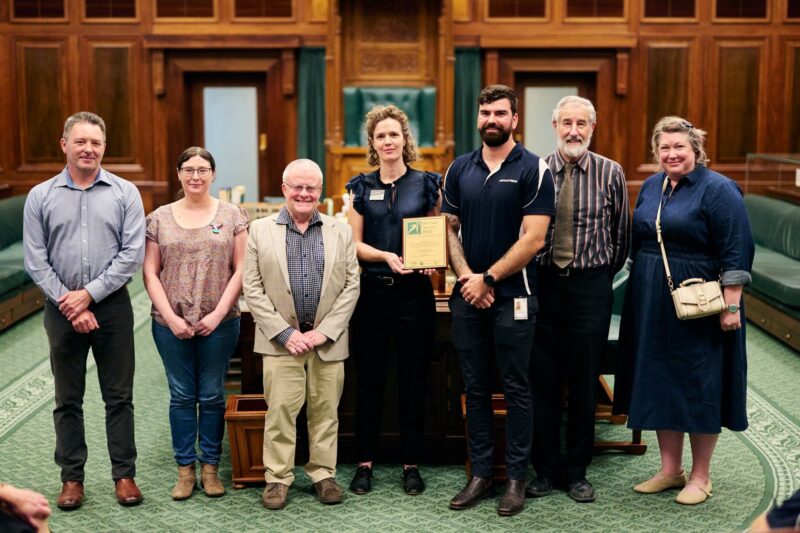
Doug Rogan attending the National Trust award win at MOAD.
National Library of Australia
Staffing
In January we farewelled Cheryl Jackson who is now enjoying well-deserved retirement after 40 years in the profession. In February we temporarily farewelled Adele Barbara who will be back in 2025 – she and her partner have welcome a healthy baby to the world!
Welcome to Sarah McHugh, who has joined the team as Program Manager, Preventive Conservation, Celeste Vallance as a Conservation Officer and Lauren Christmas who is with us two days a week working on a mould remediation project. We also welcome back Freya O’Connor who has returned from extended leave.
Key achievements
- Deinstalled the permanent and temporary gallery spaces to facilitate building works. Across three days, 302 collection items were deinstalled by staff members and Grasselli Art Services. This included moving the painting The Death of Cook, the size of which presented a moving challenge. As it didn’t fit in the lift, an IAS truck was hired to move it around the NLA to get it into appropriate storage.
- Made available online: Papers of Kristian Fredrikson, which included textiles, tracing paper and theatre sets. The Collection Care Digitisation Projects team treated more than 1,800 items across 350 hours to support their digitisation.
- Commenced a mould remediation project and completed treatment on 93 items across seven collections.
- Reviewed the collection emergency response stores and Quarantine Room and purchased new dehumidifiers, mould vacuum cleaners and a new chest freezer to support preventive activities.
- Hosted Birgit Vinther Hansen, Senior Conservator from the Royal Library of Denmark, who is working on sustainability in her institution and finding greener alternatives in conservation. She presented the new joint storage facility built for the Royal Danish Library and the National Museum of Denmark and the reorganisation of the collections following sustainable practices. Birgit also met with NLA Facilities and Building Futures teams and discussed the approach here at the Library to implement sustainable practices amid the Government’s commitment to meet NetZero.
- Presented in the British Library’s Webinar series: Libraries and positive climate action. Tania presented about the three years of smoke haze, hail and rain and the impact on collections. Nicki and Marika (colleague from Building Futures) presented on sustainable building.

The NLA Collection Care team doing one of our favourite activities – eating morning tea! From left to right (clockwise around the table) – Lucilla Ronai, Maren Innes, Freya O’Connor, Aurelie Martin, Caroline Milne, Tania Riviere, Nicki Smith, Nicole Rowney, Sarah McHugh, Maria Genetzakis, Jacinta Sanders, Cheralyn Lim, Lisa Jeong-Reuss (not pictured: Celeste Vallance, Janet McDonald, Lauren Christmas).
University of Canberra
A new year means a new batch of students starting their journey in materials conservation. This semester there seems to be a penchant for paper bleaching and gels for ceramics. We look forward to the students’ findings and wish them all the best for their treatment success.
Julia Brand has recently graduated and received her doctorate in investigating the use of lasers to clean and conserve the Sydney Harbour Bridge. Hooray and huzzah for Dr Julia Brand! She is now the Laser Cleaning Fellow at the Victoria and Albert Museum. We miss her dearly and wish her all the best in her future endeavours.
In February, Natalie Ison journeyed to the west to deliver a short course on Heritage Engineering with heritage engineer Martin Silk, Neil Hogg, Claire Rowson (ICS) and a representative from the Western Australian Government. The course was delivered over two days at the Western Australian Army Museum Fremantle. The next one, Implementation of Heritage Engineering Solutions, will be delivered in Sydney in July, so look out for that when registrations open.
The Heritage Lab also welcomed a new intern, Jade Rice. Jade will be spending the semester learning the ropes on how to run a materials conservation teaching lab and sorting out some of our archival materials. So that’s about it from the University of Canberra. Hope you are enjoying the cooler weather – till next time.
International Conservation Services (ICS) NSW
Events
In late November 2023 ICS had the pleasure of being a major sponsor of the Museums & Galleries of NSW IMAGinE Awards, held at Sydney Modern Art Gallery of NSW. The awards are an important chance to highlight the incredible work undertaken by all NSW museums and galleries regardless of size, budget and resources. It was inspiring to see the depth and breadth of the exhibitions, programs and engagement initiatives being undertaken in NSW.
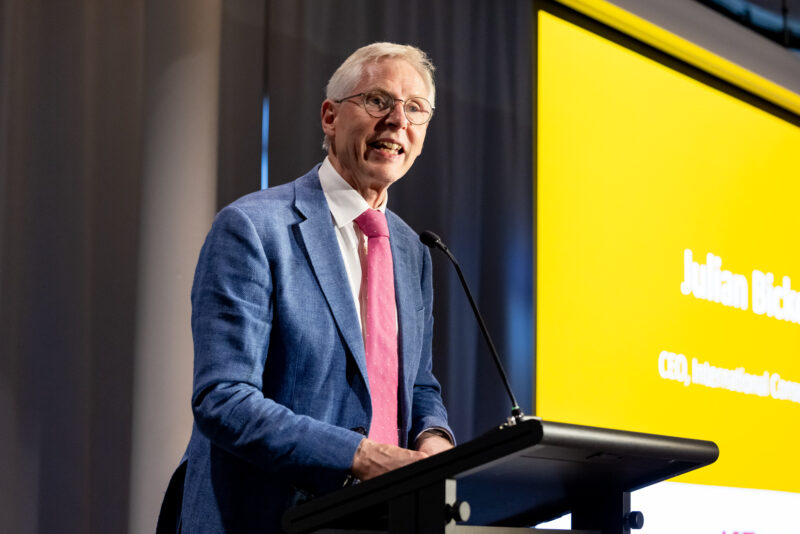
Julian Bickersteth presenting at the IMAGinE Awards held at the Sydney Modern AGNSW. Image credit Jacquie Manning.
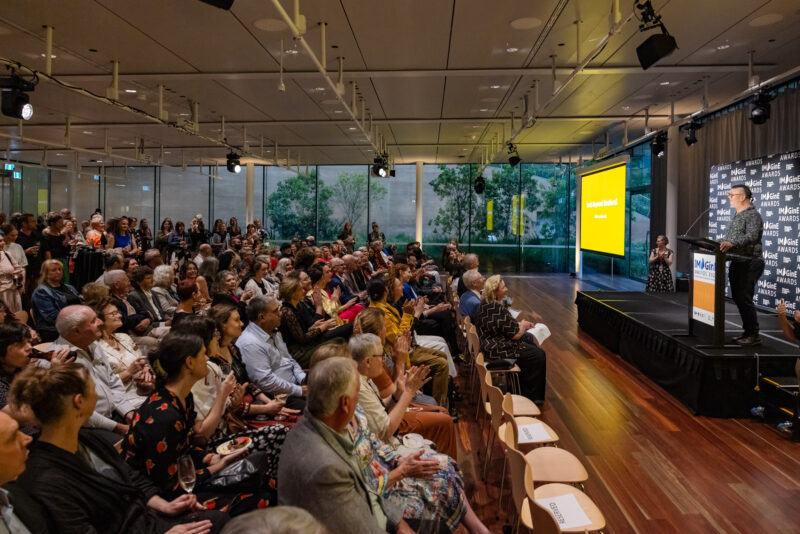
Steve Miller, Aboriginal Programs Manager at M&G NSW and General Manager of the NSW Aboriginal Culture, Heritage & Arts Association (ACHAA) presenting the ACHAA Awards. Image credit Jacquie Manning.
Awards
ICS is featured in a number of exciting and diverse projects recently nominated for the National Trust NSW 2024 Awards.
The SSILO Project – nomination for ICS
ICS project managed the relocation of The South Solitary Island Lighthouse Optic (SSILO) from a suburban table tennis club to its new prime and accessible position on the Coffs Harbour foreshore. The optic is a significant item in the collection of the City of Coffs Harbours’ Yarrila Arts and Museum (YAM).
Parliament House NSW – nomination for Purcell Architects
ICS contributed to the Parliament House NSW project through the conservation of brass and glass door handles and the conservation of gilded lettering on the glass panels within the doors. Additionally, we assisted architects in developing the specifications needed to treat various decorative finishes and materials.
The Brewery, No. 5 Central Park – nomination for Urbis
The Brewery Yard is a huge $2 billion development and a wonderful example of old and new architecture working in sync. ICS was engaged to conserve and reinstate the old brewery’s malting equipment and associated machinery. This impressive piece of kit now sits within its revamped home, standing as a testament to its original use.
The Locomotive Workshop, Eveleigh – nomination for Mirvac
The old Locomotive Workshop, built in the 1880s, was responsible for manufacturing, repairing, assembling, and maintaining locomotive steam engines. This significant heritage site has now been adapted for reuse as retail and office space.
If you wander around the new interior you can see its industrial past on display, showcasing approximately 100 pieces of heritage machinery, cleaned and conserved by ICS. These range from small furnaces to a 23-tonne milling machine, as well as the Davy Press (which forms a steampunk background for the pub) and the Genovese Drilling Machine.
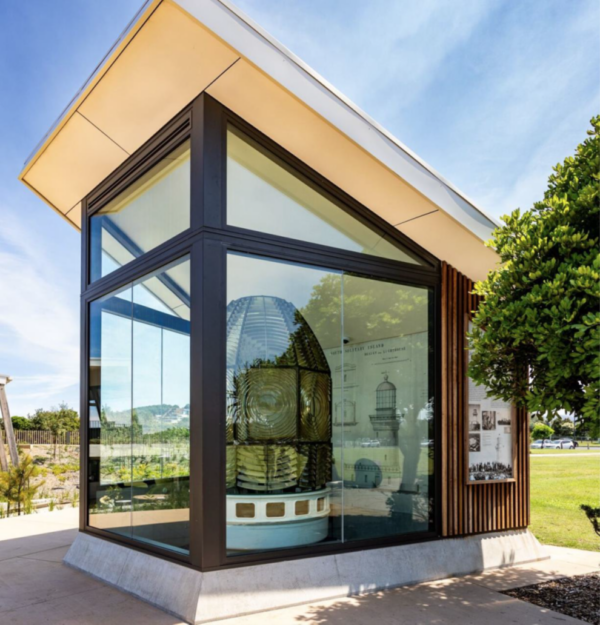
SSILO in its new housing on Coffs Harbour foreshore.
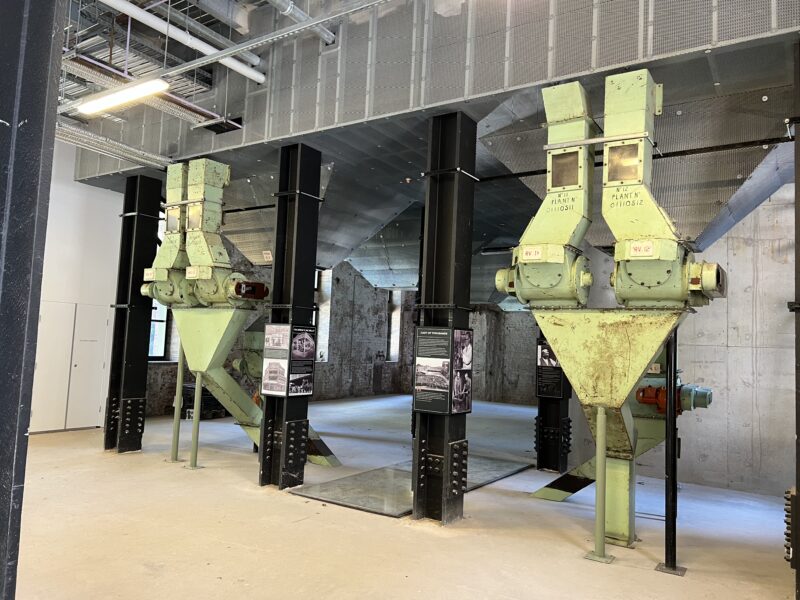
The conserved and reinstated malting equipment at The Brewery, No. 5 Central Park.
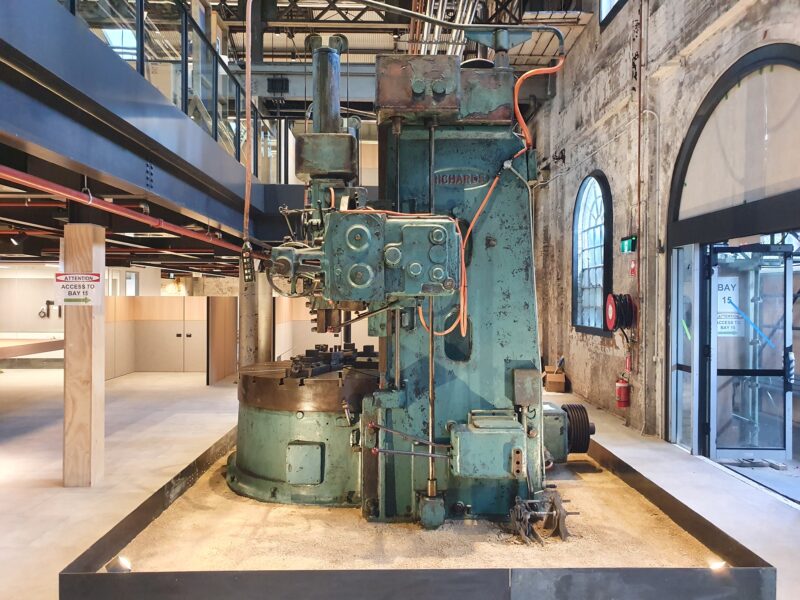
Richards vertical borer in the Locomotive Workshop, Eveleigh.
Symposiums
Doug Rogan, Head of Museum and Gallery Services, attended the Future of Arts, Culture and Technology Symposium at ACMI last month. ICS is keen to stay abreast of the latest thinking and developments, and the future trajectories of technology in the cultural sector. We aim to anticipate the future needs of our clients in the expanding world of collection digitisation, and in the conservation of software-based media and the preservation of aging technologies.
Professional development
Isabelle Waters, Conservation Projects Manager, came back with glowing reports of her five-day metalworking course taught by David Thurrowgood from Applied Conservation Science, in Launceston, Tasmania.
The focus was on industrial working metals and archaeological metals, and the course involved lectures, workshops, and demonstrations.
The course covered:
- Identification of metals and alloys
- Identification and assessment of causes of deterioration
- Treatment methods including electrochemical, mechanical/abrasive, use of inhibitors and lacquers
- Use of scientific methods and principles to assess metals and make assessments regarding treatment recommendations
- Evaluating and using commercially produced products from related industries for treatments
- International research and trends in the field of metals conservation.
Paintings
Brisbane Convention & Exhibition Centre Collection
Alis Jitarescu, Principal Conservator Paintings, Murals & Decorative Arts, Suati Rojas, Senior Paintings & Paper Conservator and Francesca Elia, Paintings Conservator, have been working on huge paintings from the Brisbane Convention & Exhibition Centre. The artworks are impressive due to both their large scale and their artistic value.
Most of the damages present are structural, with conservation issues related to both paint layers and canvas support. The conservation team is treating damages that include poor stretching, canvas tears, degraded previous conservation repairs, unstable flaking paint and other conditions that affect the preservation of the collection.
Due to their large scale, many of the challenges of this project relate to artwork handling and ensuring minimal stress is placed on the artworks to maintain their stability. The conservation team is aiming to complete the project by early April.

Working in the lab on the BCEC Collection Paintings 1.
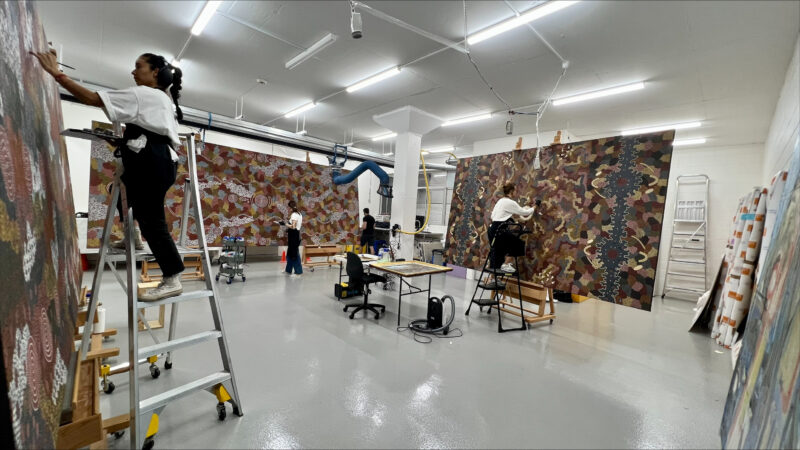
Working in the lab on the BCEC Collection Paintings 2.
NERAM
We recently received Phase 8 of the ‘Adopt an Artwork’ program from the New England Regional Art Museum. This inspiring program has raised over $404,000 since 2015, sponsoring 194 artworks from the NERAM Collections, with a value of $12.8 million.
In late March 2024, Phase 8 saw seven further adopted paintings arrive at our Sydney labs for conservation.
Icon
Alis Jitarescu did a fine job on a beautiful 18th century Greek icon. The 40 Holy Martyrs of Sabaste was brought in for conservation after falling off the wall and being rendered in two. The break was rejoined, stabilised and the painting retouched. Alis revealed details of the icon that had been lost to ingrained grime and discoloured varnish, allowing the painting to shine once more.

40 Holy Martyrs of Sabaste – before treatment.
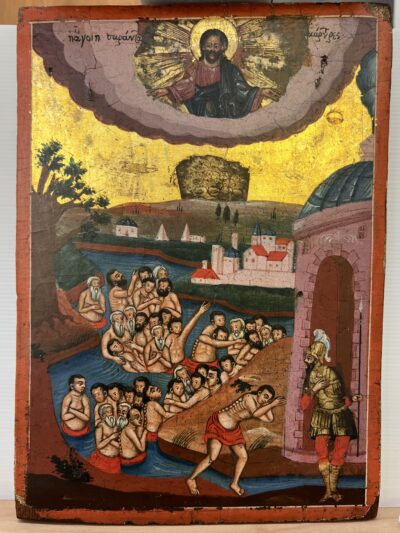
40 Holy Martyrs of Sabaste – after treatment.
Textiles
There have been some large projects in the textile department recently. In Melbourne, Christina Ritschel, Principal Textiles Conservator, worked on a wonderful, brightly coloured Marsh Arab rug. Due to a pest infestation, the rug underwent a freezing treatment, which was followed by minor stabilisation of areas affected by the infestation. In Sydney, Yolanda El Khouri and Lisa Pang surface cleaned an interesting modern pile wall hanging from Theatre Royal.
The team also conserved two tapestries from the Reserve Bank of Australia (RBA). The first, the Great Turtle Tapestry, received surface cleaning and the stabilisation of its decorative hoop ornament, plus Velcro for hanging. The second, a large framed tapestry, was treated in situ at the RBA building and was de-installed and rolled for storage.
Christina treated a beautiful but slightly eery platypus blanket. The stitched seams between the 56 furs were stabilised, and Velcro was applied along each edge in preparation for framing. Four similar blankets of platypus, quoll, possum and fox, respectively, have come in after freezing in response to an overlooked moth infestation, highlighting the importance of regular housekeeping and monitoring in collections.
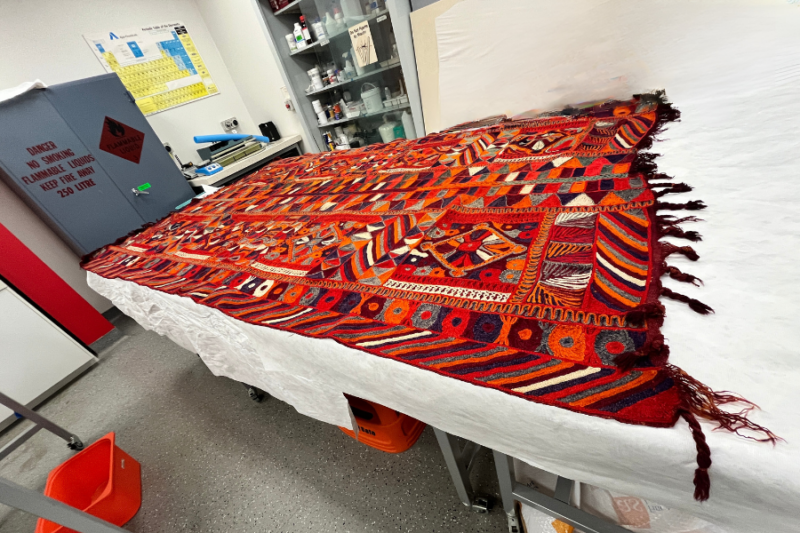
The Marsh Arab rug.

Platypus blanket with 56 furs.
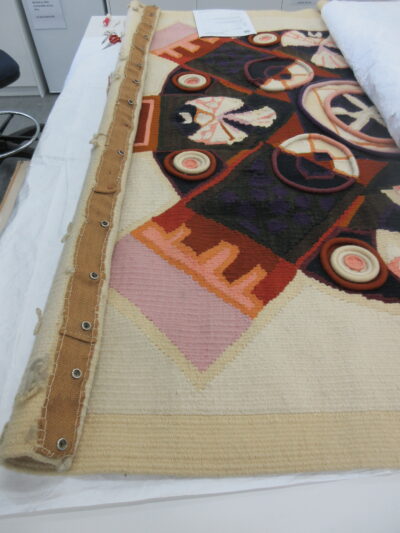
Great Turtle Tapestry.
Paper
Katie Wood, Senior Paper Conservator, Suati Rojas, Paintings & Paper Conservator and Conservation Technicians Cristiane Prado and Lisa Pang have been working on a collection of water-damaged books with split pin bindings. Treatment has included washing the pages to reduce tidelines and pressing the paper to reduce cockling.
Caroline Whitley will soon travel to Retford Park in Bowral to work on some historic wallpaper for the National Trust.
Katie and Suati recently performed several complex backing removals including one very fragile watercolour from St James’ Church, Sydney.

Collection of water-damaged books.

St James’ Church, Sydney – before.
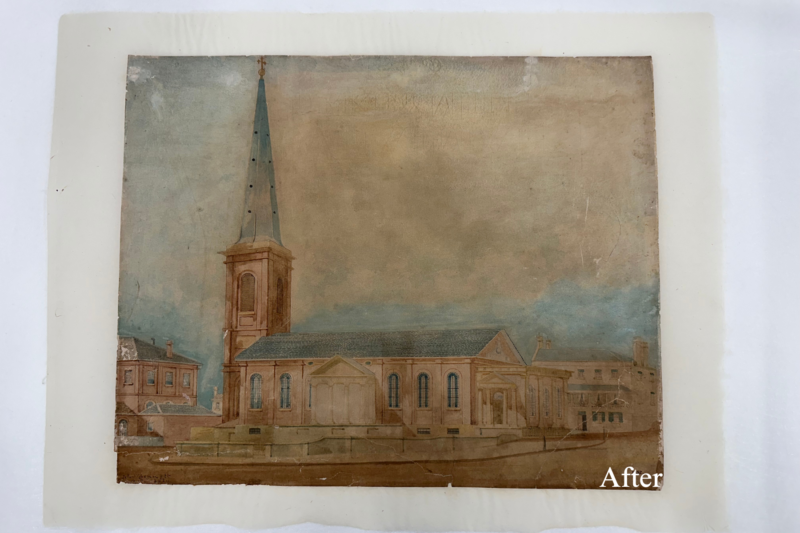
St James’ Church, Sydney – after
Under the Opera House
Julian Bickersteth and Richard Silink, Head of Conservation (Objects, Outdoor and Built Heritage), recently had the pleasure of working alongside Dr Nadia Iacono from GML Heritage, Nicola Ashurst and Built Pty Ltd to devise a methodology to conserve the archaeological remains of the early colonial fortifications beneath the Sydney Opera House.
The Opera House forms such an iconic view of Australia that it can easily be forgotten that it was not the first building to grace Bennelong Point. That first building holds a special place in the colonial history of Australia, with the land itself being of special significance for the Eora Nations prior to it being a site of European arrival in Sydney and Aboriginal first contact.
In 1821, Fort Macquarie was completed at Bennelong Point at the behest of the Governor and was modified throughout the 1800s. In 1901, the fort was dismantled, but its footings remain, even now, beneath the Opera House. ICS developed a methodology for carefully protecting the in-situ archaeological stone walls and for the partial relocation of select elements. This will facilitate the construction of a new escalator to enhance the accessibility of the building.
Objects & Outdoor Heritage
The Great Synagogue
Julian Bickersteth and Shrief Eissa have been working with the Great Synagogue in Sydney to restore the bimah (podium) to its original position in the 1878 interior. It was relocated early last century to make way for more pews. Returning the bimah to its original position will allow more space for weddings and music performances. ICS has worked closely with the rabbi and the synagogue heritage architect to identify the original components that can be reused and to test the correct height with a full-size prototype. The project also includes restoring the encaustic tiled floor, rebuilding the pulpit and the arc, and backlighting the original leadlight windows.

The Great Synagogue in Sydney.

Prototype bimah in the Great Synagogue.
The Brewery Yard display
Karen Wilcox, Objects Conservator, designed the mounts for an exhibition featuring artefacts from the Brewery Yard project. This showcase presents an array of Victorian items unearthed during archaeological digs spanning from 2009 to 2015. Among the treasures are a child’s marble, a woman’s perfume bottle, a pipe head, ink pots, ceramic bottles, and ornately decorated plates. Together, the artefacts offer a glimpse into the lives of individuals from that era, serving as poignant reminders of the area’s social history. During this period, much of the land was allocated to working-class housing, and this display pays homage to the community’s past.

The Brewery Yard artefact display case.
O’Sullivan Conservation
Staff news
To bring a busy and rewarding 2023 to an end, the O’Sullivan Conservation (OSC) team celebrated our Christmas party with a Japanese calligraphy workshop. The workshop was hosted by local calligraphy artist Tomoko, who guided the group through a series of traditional techniques using traditional materials, such as horsehair brushes, Hanshi calligraphy paper, and Sumi drawing ink. As the ink dried, the team transitioned to a Greek-fusion lunch by the Brisbane River on the Central Coast.
OSC has welcomed Mathew Geale and Anna Broome as they moved into full-time positions in the new year: Mat continuing as Metals Conservation Specialist and Anna as Conservation Technician. With OSC’s reach expanding, their specialist contributions and excellent teamwork will be an asset to the organisation.
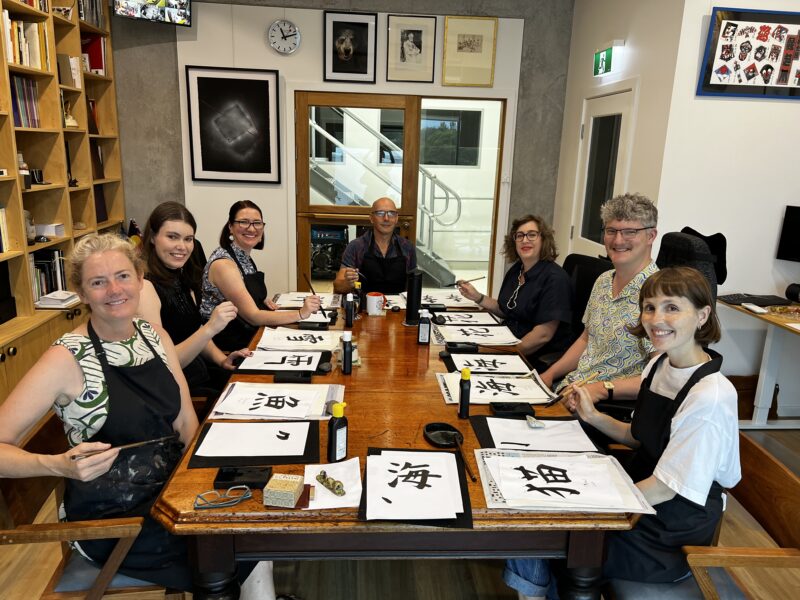
The OSC team Christmas party and Japanese calligraphy workshop.
Professional news
To fuel an active start to 2024, the OSC team completed a series of training days including a comprehensive first aid training session. The training was hosted by a local first aid specialist who held discussions and first aid activities based on contexts in which the team works, from hypothetical workshop accidents to onsite scenarios and essential CPR training. Heading into the new year, our team is prepared for any situation that may arise!
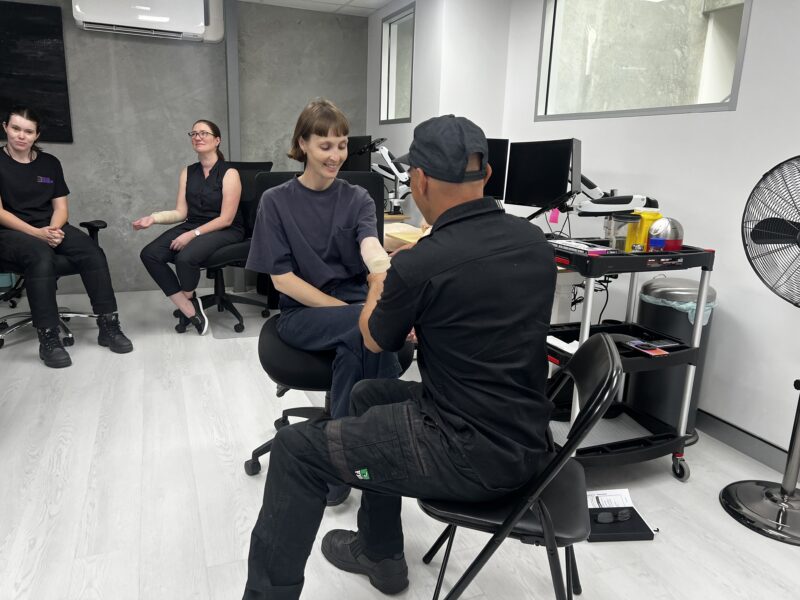
The OSC team brushing up on their first aid skills.
Treatment projects
From Christmas to courthouse, Eoin and Emily travelled to Wagga Wagga in early January for a treatment of four clockfaces on the Wagga Wagga Courthouse. The clockface frames received a recoating treatment following surface cleaning, and corrosion and coating removal. Once the new coating system had been applied and cured, the forefronts of the inner frames were gilded using 23.5k gold leaf. The work has returned the clockfaces to their original 1903 appearance and contributed to renewing the timeless character to this historic building.

Eoin preparing the Wagga Wagga Courthouse clockfaces for gilding.
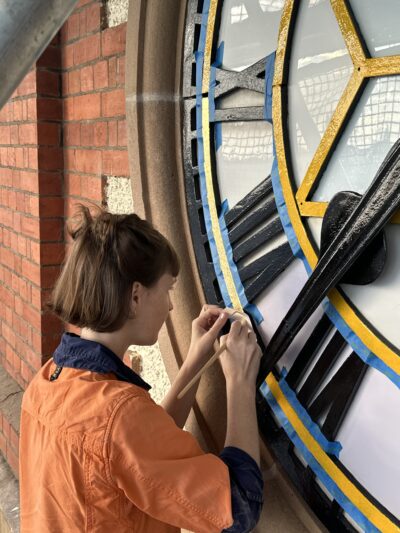
Emily gilding the clockfaces.
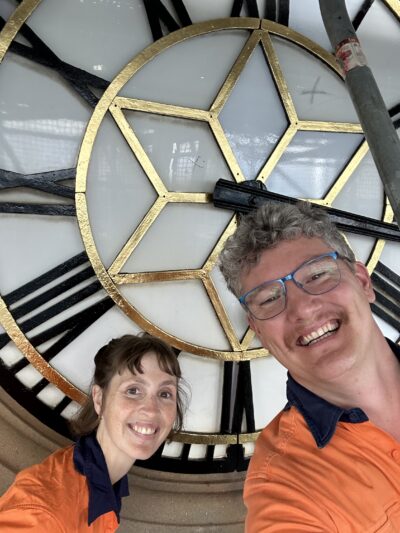
Emily and Eoin successfully completing the project!
A series of large technology items and smaller objects on display at the Australian National Maritime Museum (ANMM) received a maintenance conservation clean by Eoin, Emily, Mathew and Camilla during December. In the Main Building, elevated work platforms (EWPs) were used to access the exterior of a range of objects including the Blackmores First Lady yacht, the Tiger 75/Sikorksy S-70B-2 Seahawk helicopter, and the multi-component artwork Ghost Nets. Ghost Nets in particular required gentle manoeuvres between all its fine and elongated features. Over in ANMM’s Wharf 7, a series of sail boats, motors and kayaks were conservation cleaned, starting from the tops of sails down to the decks, offering an opportunity to observe the masterful detail of these beautifully handcrafted skiffs.
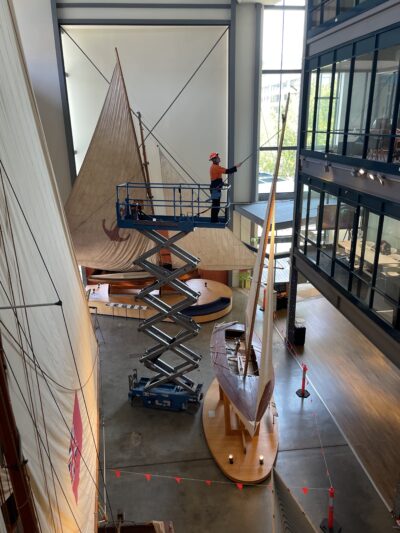
Eoin undertaking conservation cleaning of the sails of vessels in Wharf 7 at the Australian National Maritime Museum.
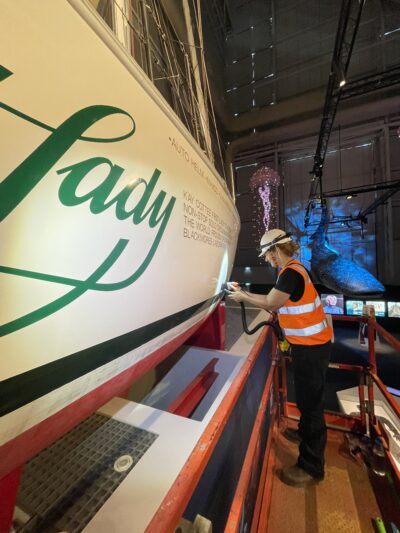
Camilla cleaning the hull of Blackmores First Lady yacht.
The Knox Grammar Old Boys’ War Memorial received a conservation treatment during January. A primary feature was the treatment of the Honour Roll; Emily co-ordinated a new central panel to be fabricated to include the names of three additional veterans, and the bordering panels to be re-finished, infilled, and patinated to match.
Following installation, Eoin, Emily, and Mathew undertook rewaxing of lettering, localised repointing, and sandstone cleaning. All completed in time for the beginning of the 2024 school year, and the 100-year anniversary celebrations.

Emily undertaking repointing of the Knox Grammar War Memorial.

The Knox Grammar War Memorial after treatment.
State Library of NSW
The focus of the Paper and Photographs team in the past few months has been treating Dunera collection items for both exhibition and digitisation. Approximately 300 items have been treated, many of which will be in the exhibition opening in August. Others have been digitised so that the full collection will be accessible through the online catalogue. The artworks were created by men sent from Britain to Australia during WWII on the ship Dunera to be interned in camps in south and west NSW because they were considered enemy aliens due to their nationalities. The artworks are a mix of dry media, watercolour, or gouache on a range of papers – often any material they could source within the camp. The treatment philosophy has deliberately been to have a light touch – mostly stabilisation. However, there have been a few that required more intervention, including solvent tape removals, washing, and lining.
Collection Care hosted a tour of students from the National Art School in late February that was part of Drawing Week at the Library. The students got to have a close-up look at Peter Kingston works being prepared for exhibition and the Dunera collection items, as well as a Lloyd Rees drawing identified as having a white ground intended to create a greater sense of contrast.
Felicity Corkill returned from parental leave in February and she and Sonia Lee are working towards collating, treating and preparing mounts for the nearly 1000 objects due to go on display in the new Objects Gallery by the end of June. Dominique Moussou is still working on the Dixson Folio collection and has recently been researching some interesting 20th century machine bindings. She is also assessing a 14th century gradual weighing 17kg for housing and treatment options.
A quiet start to the year for exhibitions and loans provided a nice opportunity for Helen Casey to work on some paintings treatments, removing discoloured varnish from two oil paintings, one by Robert Hofman and the other by Philip Glass. Both men were German internees at Hay camp, having come to Australia on the Dunera ship in 1940.
Cath Bartley and Jochen Letsch have been working on preparing items for our Amaze Galleries mixed display. Jochen has been making book supports for newly acquired rare books and to display a selection of sketchbooks from the artist Michael Kelly. Cath has been working on a display of book plates, the children’s book Horrible Harriot and several other themes. Jochen is also looking at expanding our in-house mount-making capabilities, putting together a set-up to bend 2mm and 3mm acrylic. He has a set-up for bending 1mm Vivak®, which has been very useful for making lips on book cradles when placed at an angle and making small mounts for miniatures or lightweight items. Now expanding to 2–3mm, we will be able to recycle old acrylic from used vitrines or Fini stock frames when needed.
Australian Centre for the Moving Image (ACMI)
Registration and Collections
We recently welcomed two brilliant new colleagues to our team – Julie-Anne Carbon as our Collections Management System Data Manager and Bronte Billman as our Collections Operations Coordinator. Julie-Anne joins us from the NGV and Bronte from QAGOMA and both make invaluable additions to our team.
Research
ACMI’s second annual Future of Arts, Culture & Technology (FACT) Symposium was held in February. The two-day symposium explored core themes of AI/automation, climate, and changing audiences – and how the cultural sector will change over the next ten years as a result. Guest speakers included artists and creators, senior cultural leaders, creative technologists, academics and researchers from across the creative industries. Video recordings of the presentations and panel discussions are available to watch on our website. Arts hub also did a write-up of the panel discussion Predictions for the arts canon of 2050 featuring Melanie Swalwell talking about the preservation work achieved with videogames and emulation and where this will lead in the future.
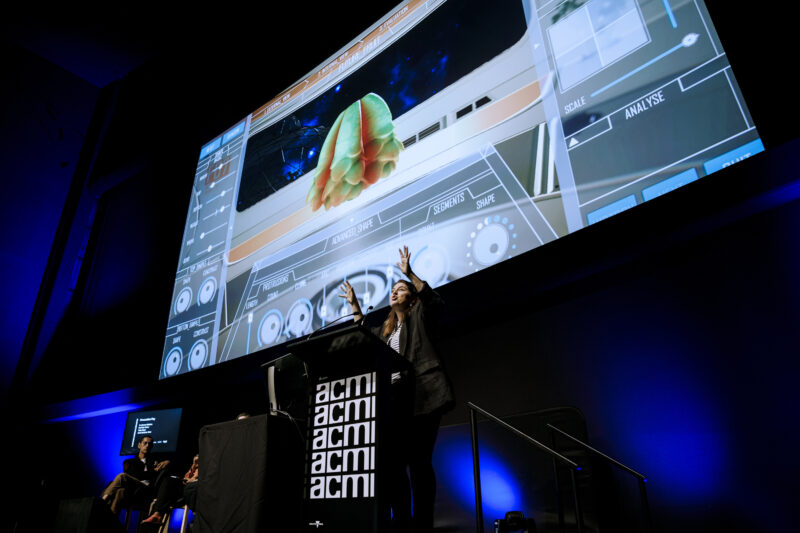
The FACT 2024 Symposium at ACMI. Image credit: Gianna Rizzo.
Exhibitions
Marshmallow Laser Feast: Works of Nature
ACMI’s exclusive Marshmallow Laser Feast exhibition Works of Nature draws to a close on 14 April. This world premiere exhibition features four major digital artworks on a grand, awe-inspiring scale – not to be missed! Through guided meditation, large-scale screen works and interactive experiences, visitors evolve from droplets of water to plants, cells and stars, becoming part of the cycle of life and the cosmos.
ACMI’s technical team was able to use five 4K 1-chip DLP laser projectors from Panasonic’s new PT-REQ Series, as well as newly developed short throw lenses. Being laser, the projectors could be mounted in a portrait orientation as landscape, pointing up or down, whereas in the past portrait projection has required the use of mirrors to rotate the image.
Stanislava Pinchuk: The Theatre of War
Part of the Mordant Family Under 35s commission series, Stanislava Pinchuk‘s new work The Theatre of War opened at ACMI on 27 Feb and runs until 9 June 2024. This multi-channel installation was commissioned in 2019, with production drastically interrupted by the COVID-19 pandemic and deeply affected by the Russian invasion of Ukraine in February 2022.
Shot in three different locations – a theatre used for cultural events during the siege of Sarajevo, a current training base for Ukrainian soldiers in the UK, and the tomb of Homer on the Greek island of Ios – The Theatre of War features three performances of the opening lines from The Iliad, all filmed in settings that represent the title of the work.
Touring
Goddess
ACMI’s 2023 Melbourne Winter Masterpieces® exhibition Goddess: Power, Glamour, Rebellion is on the move! Registrar of Touring, Angela Petrow has recently arrived at the ArtScience Museum in Singapore and is busy working with the team at ASM to install the exhibition in readiness for its opening on 6 April.
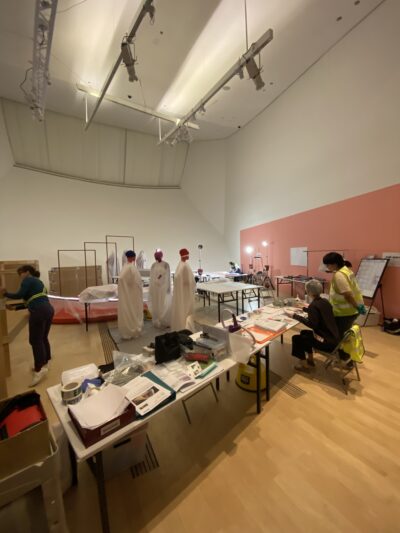
Installation is underway at the ArtScience Museum in Singapore. Image credit Tegan McAuley.
Between the Details: Video Art from the ACMI Collection
Between the Details is also on tour at Flinders University Museum of Art and will run from 19 February until 19 April. Showcasing five moving image artworks by Australian artists, this exhibition celebrates ACMI’s vibrant collecting and commissioning program featuring Kaylene Whiskey, Jason Phu, Deborah Kelly, Zanny Begg and David Rosetzky.
New acquisitions
ACMI has recently commissioned some exciting new artworks from Liam Young, Hannah Bronte, Serwah Attafuah, Ian MacLarty and Vidya Rajan.
Delta Conservation
Harpreet Tanday is a conservator of mural paintings, stone and built heritage, and an AICCM and IIC member. She runs Delta Conservation, a private conservation business in Melbourne specialising in mural paintings, stone surfaces, built heritage and paintings.
She has recently joined AUSTRALIA ICOMOS and has become a committee member of ISCMP – International Scientific Committee on Mural Painting, representing Australia at the international conservation community.

Harpreet Tanday. Image credit: Delta Conservation 2024.
Grimwade Conservation Services
Professional development
The Objects lab had the opportunity to send two staff members to participate in workshops hosted by the Centre for Rare Arts & Forgotten Trades in Ballarat. Assistant Conservator of Objects Eliana Urrutia-Bernard undertook Hand Caning and the Leadlight Restoration Demonstration, and she is now confident with the weaving of cane seating and backing for furniture conservation and is already undertaking treatments for existing clients. Dr Evan Tindal participated in the blacksmithing workshop Forged and Formed: Copper Serving Utensil, furthering his knowledge and skills in the art, repair and conservation of metals.
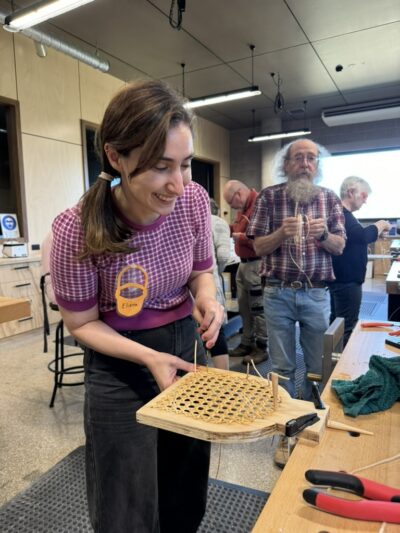
Eliana Urrutia-Bernard weaving cane.

Evan Tindal blacksmithing.
In the lab
The Objects lab recently undertook treatment on Boroondara City Council’s large outdoor timber sculptures known as The Greythorn Icons. All five sculptures were pest infested and required fumigation, stabilisation, coating and reinstallation. After several months of work in the lab they have just been reinstalled, with the help of a crane truck, on their mounts beside Doncaster Road in Balwyn North.
The paintings lab continues to work on a suite of bark paintings from the Donald Thomson Collection at the University of Melbourne, in preparation for the upcoming exhibition 65,000 years: A short history of Australian Art.
Staff
The Paper lab welcomed a new graduate intern this year, Hayley Nolle. Funded by the University of Melbourne’s Miegunyah fund, Hayley’s internship will focus on developing skills in book conservation, under the tutelage of Paper and Book Conservator, Peter Mitchelson. Hayley’s work program will include treatment of a number of items from the Baillieu Library’s Rare Book Collection.
The Objects and Textiles labs will farewell graduate intern Larry Edwards. During his internship, Larry undertook research into wet cleaning of textiles, using the 1870 Trewhella wedding dress from the Daylesford Museum as a case study. Larry explored the challenges of conservation versus restoration with such textile items in his treatment of his dress. Larry will be starting up his own private practice, based out of his studio in Hepburn, Victoria.
The Paintings lab will welcome a new graduate intern, Rachel Davis, who will be returning to Melbourne from New Zealand. Rachel completed her Master of Cultural Materials Conservation in 2023 and has since been working on selected projects at the Auckland War Memorial Museum, Christchurch Art Gallery Te Puna o Waiwhetū and Museum of New Zealand Te Papa Tongarewa. We look forward to having Rachel joining us for the next 12 months.
Grimwade Centre for Cultural Materials Conservation
An enthusiastic group of commencing students joined existing students from the master’s program, in the subject: Conservation in Theory and Practice. Many have taken advantage of the AICCM’s offer to students and, with a compelling introduction to AICCM from Victorian Branch President Charlotte Walker, are now members of AICCM. If you see them at AICCM functions, please welcome them to conservation!
Grimwade student internships
In Semester 1, 2024, Master of Cultural Materials Conservation students at Grimwade Centre for Cultural Materials Conservation undertake compulsory internships with ArtLab, Australian National Maritime Museum, Christchurch Art Gallery Te Puna o Waiwhetū, Grimwade Conservation Services, Gold Dragon Museum, Melbourne Holocaust Museum, Museums Victoria, National Film and Sound Archive of Australia, National Gallery Victoria, Queensland Art Gallery | Gallery of Modern Art, State Library Victoria, and University of Melbourne Museums & Collections. We at the Grimwade Centre extend our gratitude to our generous internship hosts. As part of the program, our students are required to complete a compulsory three-week internship as part of their final year of studies with an elective option of extending placements to six weeks. We are immensely thankful to each organisation and their teams for their generosity, mentorship, and for playing a pivotal role in developing the next generations of conservators. We look forward to reading about the projects our students have had the opportunity to contribute to when we mark their reports in June.
Visiting Indigenous Fellow
The Grimwade Centre was fortunate to have Visiting Indigenous Fellow Gabriel Nodea spend two weeks with us in March, completing his research and writing a book chapter on Gija history. Gabriel is an alumnus of Grimwade, having completed the Specialist Certificate in Cross-Cultural Conservation and Heritage in 2018 (those of you who attended the AICCM Conference in Melbourne will remember Gabriel chairing the graduate presentations from the Spec Cert graduates). Gabriel continues to teach regularly into the program, and more recently also teaches into subjects in History and Curatorial Studies.
ICS Melbourne
ANZ Gothic Bank
Our Melbourne team, comprising Katie Smith, Zora Sanders, Eden Christian, Toni Sampson, Kristine Allinson, Rebecca Clendinen, and Kai Scott, has been super busy over the past few months undertaking conservation works on a mosaic floor in the ANZ Gothic Bank at 380 Collins Street, Melbourne.
The Gothic Bank was built between 1883 and 1887 for the English, Scottish, and Australia Chartered Bank (ES&A), the forerunner of Australia and New Zealand Banking Group Limited (ANZ). Its interiors are as sumptuous as its exterior, with highly decorative walls and ceilings, elaborate joinery, and mosaic floors. As part of refurbishment works to the banking chamber, the mosaic floor was exposed to conserve and reunite this important mosaic with the rest of the decorative scheme in the chamber.
ICS was asked to assess and develop a treatment methodology for an area of mosaic that is approximately 64m². From January to March, our team cleaned the remaining mosaic, consolidating and stabilising areas of debonded tiles and screed, and reconstructed significant sections of loss. The result is a whole, fantastically vibrant mosaic, which can be viewed in the refurbished ANZ Banking Museum that is now open to the public. We highly recommend popping your head in if you’re ever on Collins Street in Melbourne.

The original mosaic flooring.
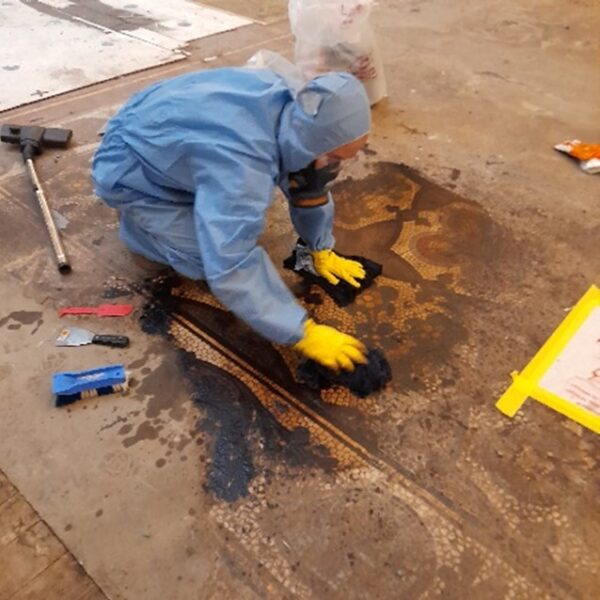
Exposing the mosaic.
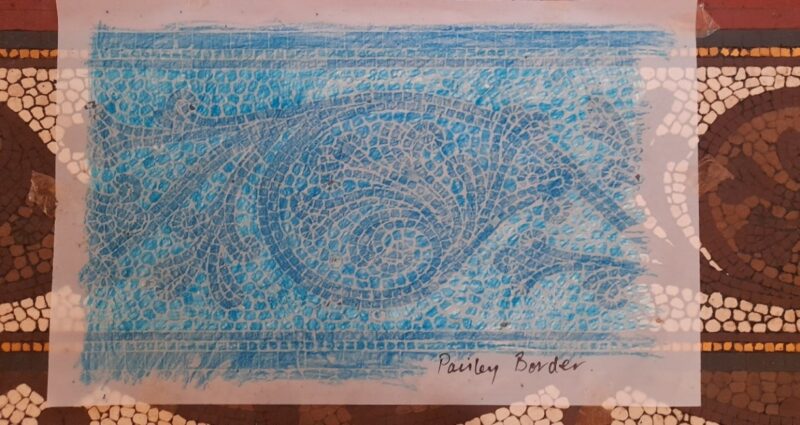
Mosaic rubbing.
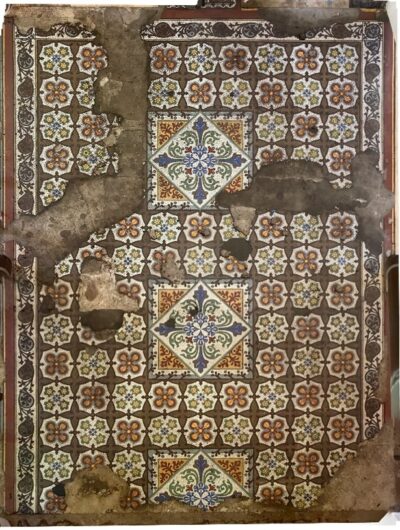
Exposed mosaic before treatment.
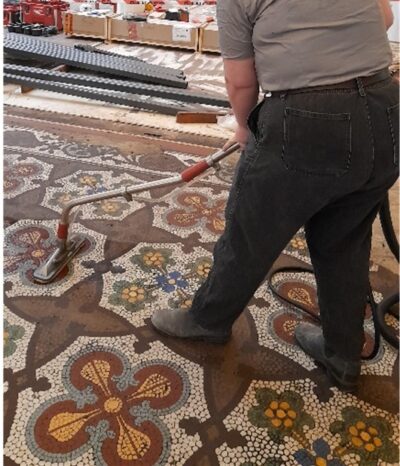
During treatment 1.
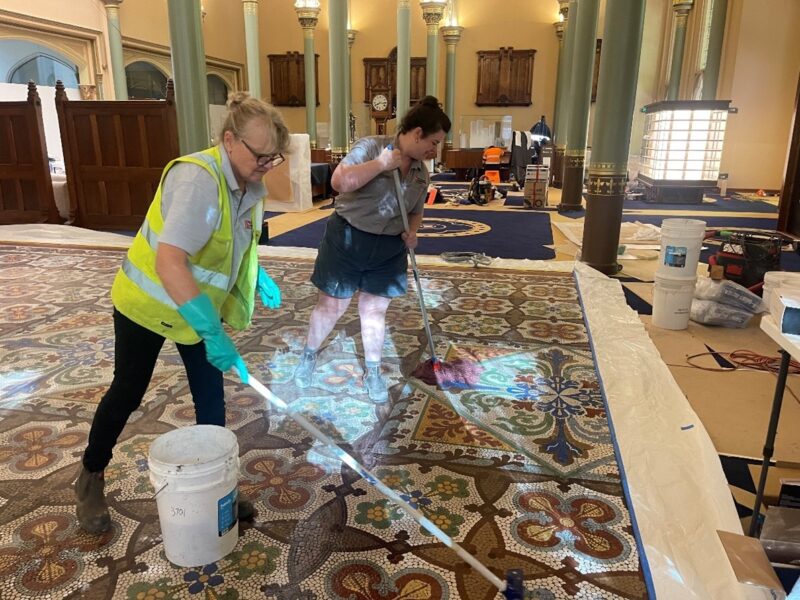
During treatment 2.
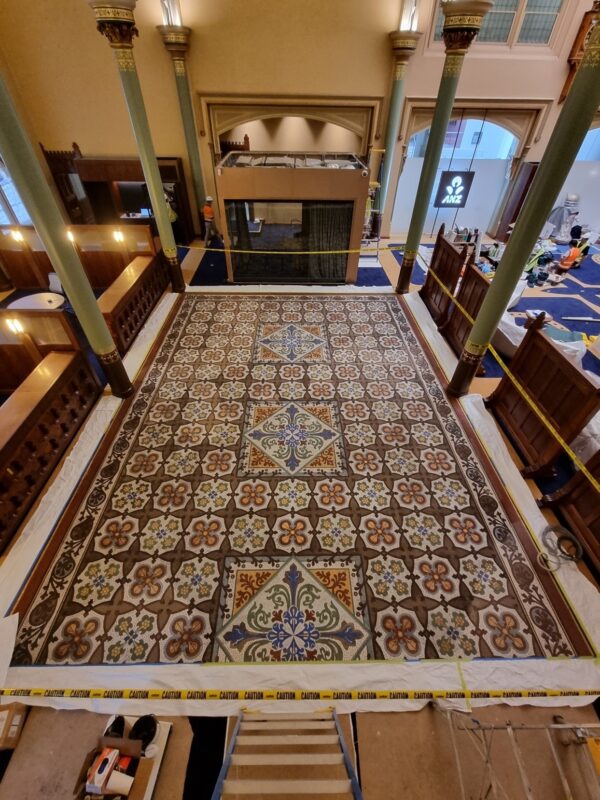
The completed mosaic flooring.
St Vincent de Paul Statue
In early March, Zora Sanders, Objects Conservator, completed conservation works on a statue at the former South Melbourne Boys’ Orphanage ahead of St Vincent de Paul Society’s 170th anniversary celebrations.
The statue of St Vincent de Paul with two children stands 120cm tall, on a concrete plinth. Previously overpainted in white, the paint losses and biological growth on its surface had resulted in a very mottled appearance.
Zora removed the existing deteriorating paintwork, cleaned the substrate beneath and applied fills where necessary. St Vincent was given a new application of paint designed to last in the outdoor environment, along with a high-performance coating to protect against other environmental factors such as further biological growth.
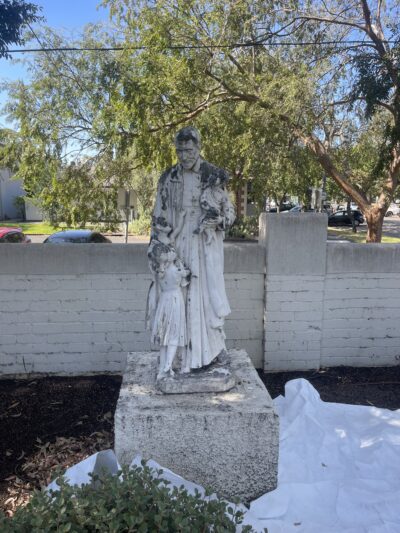
St Vincent de Paul before treatment.

St Vincent de Paul during treatment.

St Vincent de Paul after treatment.
Ballarat
Team members Zora and Kai completed the annual maintenance of works at Ballarat Botanical Gardens before the annual Begonia Festival.
During the landscaping works, the Claxton Fountain was protected beneath boarding. With works completed, the protection was removed and the fountain cleaned, ready to be unveiled to the public.
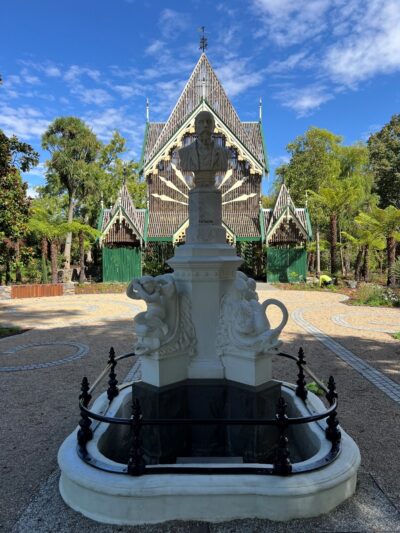
The Claxton Fountain, Ballarat.

The Claxton Fountain, Ballarat 1.
Kristine Allinson
We’re very happy to welcome back our Project Manager Kristine Allinson following her parental leave!
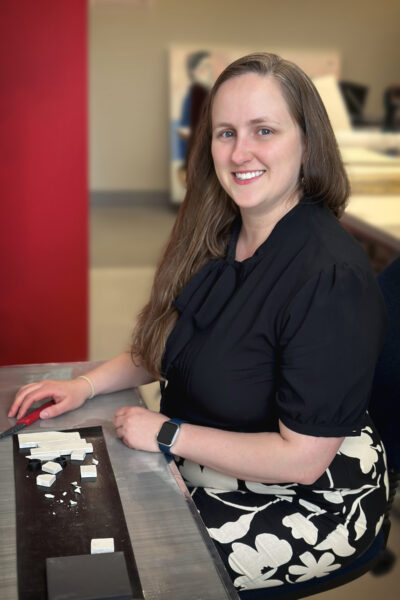
Kristine Allinson
Monash Works
Rebecca Clendinen, Graduate Conservator, has been working on an assortment of Slavic paper works – some artworks, texts and a book – from Monash University, to be displayed in April for their upcoming Ada Booth exhibition. Ada Booth’s Slavic collection contains a broad representation of Slavic, Eastern European and Eurasian works for academic studies, with a particular focus on modern and contemporary literature, history, politics, international relations, social studies and arts.
Paintings
Eden Christian, Conservation Projects Manager, has had a steady stream of paintings conservation treatments since the beginning of the year. One was a lovely portrait of Mary Queen of Scots, which is now awaiting a fresh new frame.

Mary Queen of Scots before treatment.
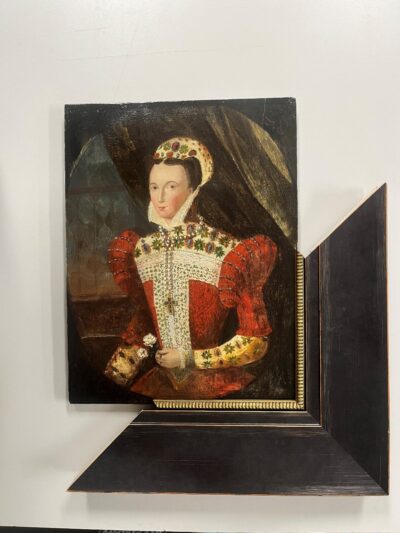
Mary Queen of Scots awaiting a fresh frame.
National Gallery of Victoria (NGV)
General
Michael Varcoe-Cocks, Associate Director, Conservation, has been busy in his role on the steering committee of the design team for NGV-C. Conservation Project Assistant Manon Mikolaitis continues to assist with the auditing, collection management, and preservation planning of the NGV’s time-based media collection.
MaryJo Lelyveld, Manager, worked in collaboration with colleagues from the University of New South Wales, Art Gallery of New South Wales, Monash University Museum of Art, TATE UK and independent artist Shelley Lasica to deliver a series of events as part of the project Precarious Movements: Choreography and the Museum, which were held at NGV on 15 and 16 March. The artist panel, book launch, and keynote, in addition to two performance pieces by Melbourne-based artists Atlanta Eke and Amrita Hepi, mark the culmination of the three-year project funded by the Australian Research Council (ARC), which looks at the presentation, acquisition, and preservation of performance art within the museum context.
Paintings
The installation of the NGV Triennial at the end of 2023 capped a busier than usual year of exhibition and loan preparation for the NGV Painting Conservation team. The new year provided the group with a chance to re-focus on the ongoing treatment program. Carl Villis completed work on a new acquisition, Madame d’Angot (1772) by François-Hubert Drouais, and commenced a major cleaning and restoration of a large canvas by Salvator Rosa, Romantic landscape with Mercury and Argus (c.1655). Caitlin Breare has begun work on Hercules and Antaeus (c.1625), a small panel painting by Peter Paul Rubens. Raye Collins has continued her work cleaning a pair of paintings by Ralph Balson (both entitled Constructive painting, 1941, 1950) in preparation for the upcoming NGV exhibition of work by Balson and Grace Crowley, which opens in May. Raymonda Rajkowski has alternated between treatments on paintings by Asher Bilu (Graphite painting, 1969) and Peter Upward (Ocean rider, c.1972). The team is also in preparation mode for the temporary relocation of the conservation labs to the newly constructed spaces on the third floor of the St Kilda Road building during the building works for NGV Contemporary.
Frames and Furniture
The Frames and Furniture lab hosted Lisa Charleston, Conservation Technician at the Tasmanian Museum & Art Gallery, for a one-week professional placement in February, with a focus on frame conservation and gilding.
Suzi Shaw is wrapping up a lot of small projects, such as a poster for storage areas about hazardous substances in the collection, and working with IT to integrate smart switches to control powered artworks’ activation timing.
Holly McGowan-Jackson has taken the opportunity to undertake treatments on several large frames temporarily removed from permanent display due to the Triennial exhibition or treatment of the painting. This includes the splendid mid-18th century English Rococo frame on The Immaculate Conception by Bartolomé Esteban Murillo (c.1665). Disassembly of the frame, necessary to allow it to be removed from the gallery, has allowed access to the mortice and tenon joints that required localised consolidation and repair to ensure they function correctly into the future.
Textiles
Textiles conservation is currently hosting Grimwade (Melbourne University) student Vicki Car for a six-week placement. Vicki is embarking on the treatment of a 19th century Worth gown and making a display support for an 18th century whalebone corset. She is also helping the lab with its busy program.
Objects
The objects conservation team has been busy with ongoing maintenance of the many complex works on display as part of the Triennial. The team has also started preparing for the deinstallation of this exhibition and the reinstallation of collection galleries across the NGV International building. Artworks for the upcoming exhibition My Country – First National Commissions have been arriving for preparation and conservation assessment, including an installation of several hundred ceramic boab nuts.
Objects conservation has also been supporting a major project to photograph, x-ray and 3D scan ancient Greek pottery in the collection. They are also investigating exciting opportunities presented by the recent purchase of a new SLA 3D printer, including gap-filling and mount-making.
Decorative arts fellow Robyn McPherson has started the treatment of a beautiful but damaged 19th century micro mosaic. In the collection since 1900, this work has never been displayed due to its condition – it will be great to finally show this intricate work to the public.
Previously NSW-based objects conservator Kasi Albert joined the team at the start of February. She is excited to be a part of the NGV conservation department and to work with such a huge and varied collection. The department and in particular the objects team are absolutely delighted to have Kasi in the team.
State Library Victoria, Collection Care
Staff changes
In January we said a fond farewell to Shelley Jamieson, Head of Collection Care, as she takes on her new role as Coordinator of Heritage, Art and Cultural Collections at the Parliament of Victoria. Shelley started with the Library in 2004 as Conservation Coordinator. Her impact over the past 20 years has been immense. Arguably one of the most obvious and enduring impacts of Shelley’s time at the Library is our magnificent Conservation Studio, a custom-built laboratory that was championed by Shelley and undertaken under her leadership. More recently, the Library’s accreditation to the Protection of Cultural Objects on Loan scheme and the establishment of the Library’s first Preventive Conservator role, are a testament to the great legacy Shelley leaves with us. The list is long, but above all, we will miss Shelley’s incredible support, guidance, advocacy, and joyous laughter. Shelley has truly been a champion of the Collection and a wonderful advocate of the work we do in Collection Care. She will be greatly missed!
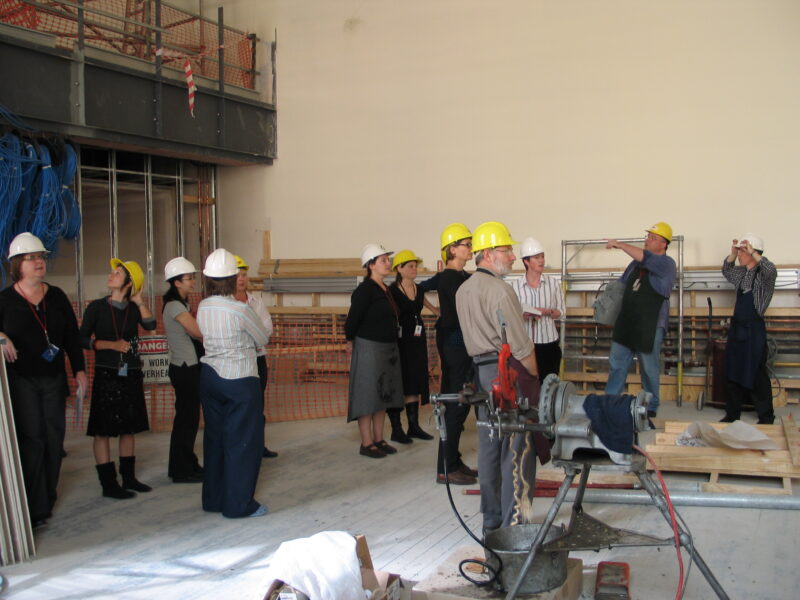
Conservation laboratory during renovations, 2005.
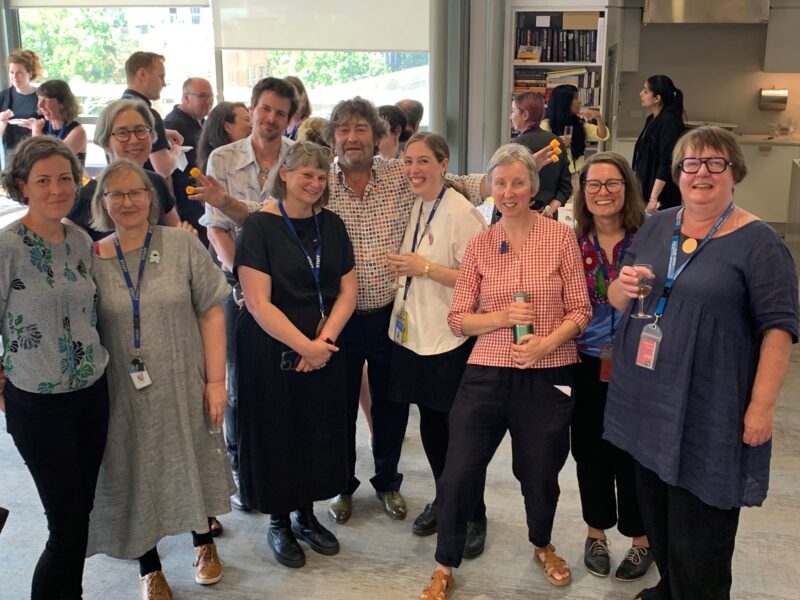
Shelley’s farewell with some of the Collection Care team, 2024.
Social news
Katy Glen, Paper & Photography Conservator, published a wonderful blog post in February entitled Melodrama in Miniature – the conservation treatment of model set pieces from the 1902 play ‘The Breaking of the Drought’. The blog highlights the ambitious set designs of John Brunton, brought to the stage by Bland Holt’s immensely popular theatre company.
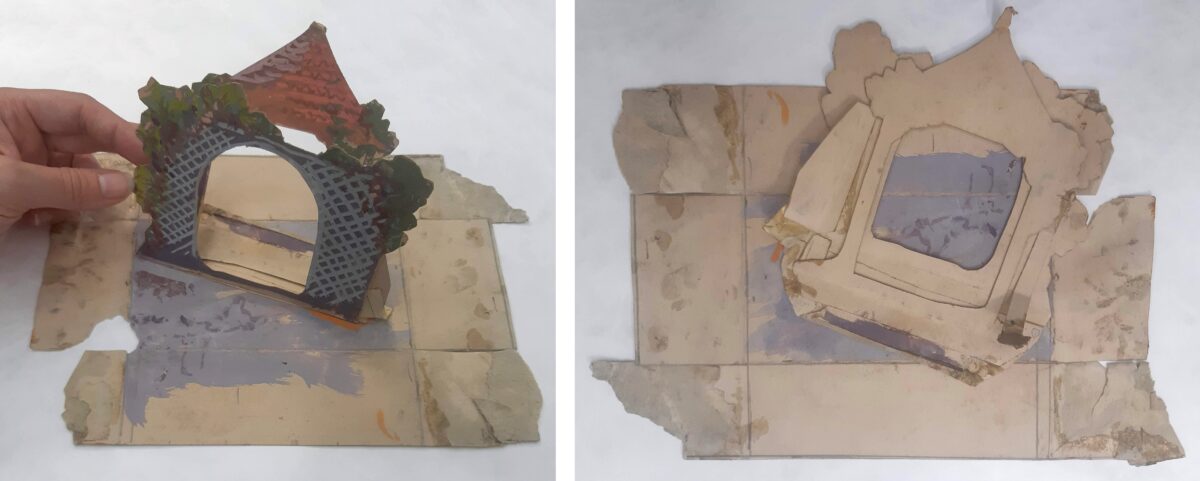
Platform set piece from Manly Scene, showing upright position (left) and folded flat (right), The Breaking of the Drought, Coppin Collection, MS 8827, State Library Victoria. Image credit: Albertine Hamilton.
Events
The Conservation Department recently hosted second-year paper conservation students from the Master of Cultural Materials Conservation course at the University of Melbourne. This is an annual event with the book conservation team sharing their extensive knowledge of book structures and how to make custom phase boxes. Senior Paper Conservator Marika Kocsis and the paper team offered insights into paper conservation at the Library, shared what they were working on, and their tools and treatment methods of choice.
Professional news
In light of the current cricket ‘plague’ in Melbourne, Preservation Manager Kate Holloway provided a pest update at a recent meeting to inform staff of what to do if they come across crickets in the Library. ‘We’ve seen them, we’ve heard them, they’re everywhere!’ It has indeed been a bumper season for crickets! While reassuring staff that black field crickets (Teleogryllus commodus) are not a risk to collection material, Kate emphasised that they do provide a rather delectable food source for larger pests, such as rodents. Kate’s advice: If you can catch them and release them into the wild that’s terrific; they do a lot for the environment. If they are deceased, pop them in the bin.
In February we welcomed back Dr Rosemary Goodall, Materials Scientist from Museums Victoria, who assisted with the ongoing testing for arsenic across our collection of books. After researching the wallpaper samples held in the collection, Paper Conservator Christine Mizzi selected a few targeted samples from two William Morris sample books [RARESEF 745.3 M83] for testing to determine the presence of arsenic and other hazardous pigments. This will enable us to establish appropriate handling guidelines for staff and public as part of our ongoing hazards in the collection audit in conjunction with the Preservation team.
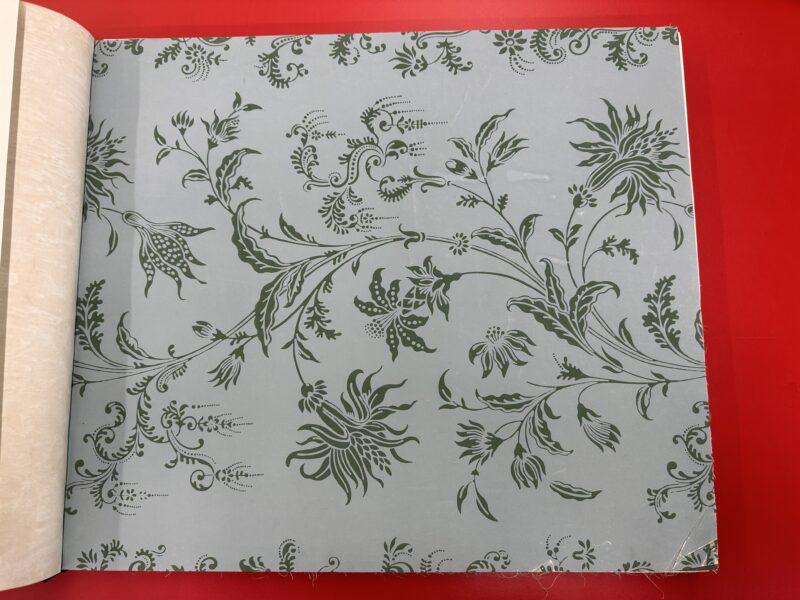
Wallpaper containing arsenic, Spray 26 [Designs for wallpapers by William Morris] RARESEF 745.3 M83, vol 1. State Library Victoria. Image credit: Christine Mizzi.
Treatment work on the Butterfield project, which comprises 154 architectural plans for St Pauls Cathedral, continues unabated. The paper conservation team recently completed another full-scale plan measuring a massive 3365 x 2225 mm.
Marika Kocsis, Senior Paper Conservator, is preparing a sketchbook belonging to John Cotton, with sketches and descriptions of birds and other flora and fauna indigenous to the Port Phillip District of New South Wales [MS 9817 (1844–1849)] for display in the upcoming World of the Book exhibition. Treatment has included stabilisation of the cloth-covered boards, repair of small tears and reinforcement of creased corners and sewing holes, ready for our book conservation team to re-sew the volume, with the view to re-case into the existing binding. Marika is thoroughly enjoying the detailed sketches and handwritten descriptions throughout.
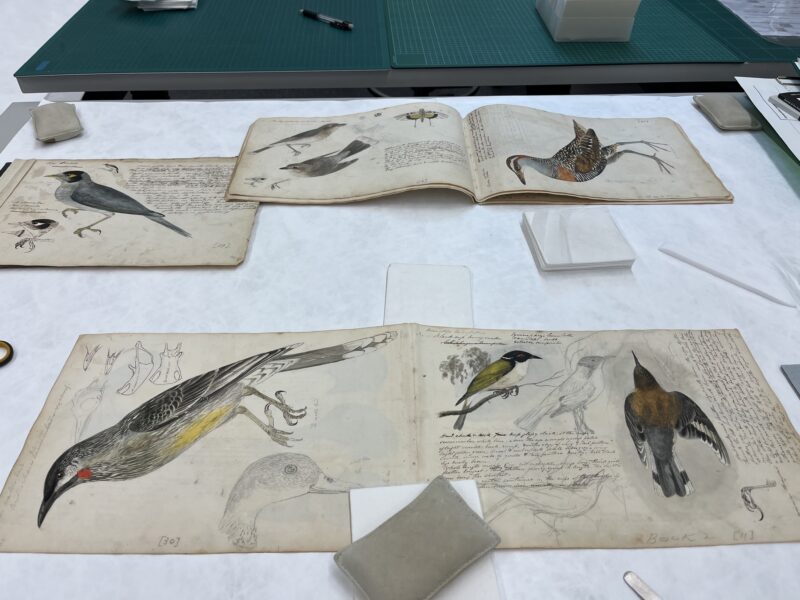
Preparing loose leaves from John Cotton’s sketchbook, MS 9817, State Library Victoria. Image credit: Marika Kocsis.
Jessica McElhinney, Paper Conservator, has been trialling methods for mounting a work on tracing paper in preparation for upcoming loan. She has been experimenting with a combination of heat-activated hinges made using Lascaux 498 HV and Japanese kozo paper, and photo-corners.
Exhibitions
William Strutt’s iconic Black Thursday, February 6th. 1851 has left the building. Accompanied by Conservation Manager Jane Hinwood, the large painting has travelled to Sydney’s Museum of Contemporary Art for the 24th Biennale of Sydney Ten Thousand Suns exhibition until 10 June.
Conservation is in the final stages preparing for the next rotation of World of the Book in May. Some highlights to come are a display of recently acquired books funded through the Women Writer’s Fund and some beautiful albums with botanical specimens of seaweed and ferns, compiled from various collections across the Library.
Conference and training attendance
In February the book conservation team attended the five-day course English Bookbindings 1450–1850: Identification and Interpretation, presented by David Pearson at State Library Victoria as part of the Australian & New Zealand Rare Book School 2024. The course gave an in-depth look at bookbindings of the handpress era, with a view to being able to understand, date and recognise interventions in books of this period. A bonus was the use of the Library’s Emmerson Collection to provide examples of the range of features David discussed. David was a fantastic lecturer, and we came away from the course able to see familiar books in a completely new light.
The book team has also been immersed in all aspects of cradle making in the lead-up to installing the next iteration of World of the Book. In February, Emily Keppel attended a very practical ‘Museum Board Cradle’ webinar presented by Abigail Bainbridge (Bainbridge Conservation), while in March, Katrina Ben attended the online session of the ‘Design and Construction of Reusable and Modular Book Cradles’ conference organised by CCI where Alessandro Scola (John Hopkins Sheridan Library) presented his system of reusable and modular Vivak book cradles. Both webinars comprehensively addressed the important structural issues of books and offered useful ideas to streamline the process of creating book supports, encompassing different opening angles, tilts, and materials. While we will continue using our well-established cradle system, the team now has a few more tricks to add to our cradle-making repertoire!
State Library of Western Australia
Exhibitions
The conservation team, including Cristina Albillos, Natasha Trenear and Libby West, has been busy preparing loans and collection material for display in the summer and autumn exhibition program at the State Library. These include original illustrations by First Nations author Helen Milroy, featured in Crow Baby, a history of brewing in Western Australia with Liquid Gold, and early South-Asian migration in Sheiks, Fakes and Cameleers.
Long Play Vinyl collection
Cristina Albillos and Susan Anderson have completed the surface cleaning and rehousing of more than 400 long play vinyl records in the collection. All have been surface cleaned with an ultrasonic water bath, digitised in the SLWA Sound Studio, and rehoused into custom cut archival boxes using the much-loved Valiani Maximus box cutter.
Research
Recent conservation graduate Lorna Flynn has been busy sharing her knowledge of x-ray fluorescence (XRF) by undertaking pigment analysis of 1828 portraits of John Gregory and his family prior to their arrival in Western Australia. Her XRF analysis has identified that the portraits contain arsenic, confirmation that they must be handled with extra precautions, and that their frames have a copper leaf coating.

Lorna Flynn undertaking XRF analysis.
WA Division news
After 18 months as State President, we farewell Gaynor Ashford as she has handed over to Claire Rowson, who, with a great committee, will guide for the next while. We would like to take the opportunity to thank Gaynor for her wonderful contribution to keeping our WA chapter thriving over the last 18 months and are thrilled to have her staying on as a general committee member.
Embroiderer’s Guild of WA
Gaynor, as part of the Embroiderers’ Guild of WA Textile Collection Group, will be working on a few community museum textile projects, both preparing them for long-term storage and for a new life after a serious conservation facelift. She is also contributing to the Collections WA project collaborating with Natalie Evans from AMaGA and Royal WA Historic Society. Gaynor is looking forward to the Textile SIG to be held at the NGV in June, where she will make a presentation about the development of the New Parliament House Embroidery 1984–88.
Heritage Conservation Solutions
Ian MacLeod joined Kevin Jones, former Director of the SA Maritime Museum, for a three-week review of the Queensland Maritime Museum. Each day we travelled two stops up-river from Kangaroo Point to the landing for the Maritime Museum and experienced the hot and humid weather that the outdoor artefacts routinely experience. One certainly gets a better understanding of the power of the incoming solar radiation when standing in the full sun reviewing the external exhibits. There were some really superb collection items, such as a Queensland Navy frock coat with superb HMQN gilded brass buttons on it. The pride of the place is the former HMAS Diamantina in the 19th century dry dock. The Pink Lady that took Jessica Watson around the world on her solo voyage as a teenager was an impressive sight, made all the more so by the youth of the sailor. Some hidden gems were a 1906 photographic album of pearl fishing in Torres Strait. The highlights were meeting dozens of volunteers, one of whom turned 93 while we were there. A report will be prepared and presented to the Queensland Dept of State Development.
Having returned to WA, Ian then travelled to spend time at the Discovery Bay whaling station doing a corrosion assessment of the Cheynes IV whale chaser. This is part of the review being conducted by Hocking Planning and Architecture.